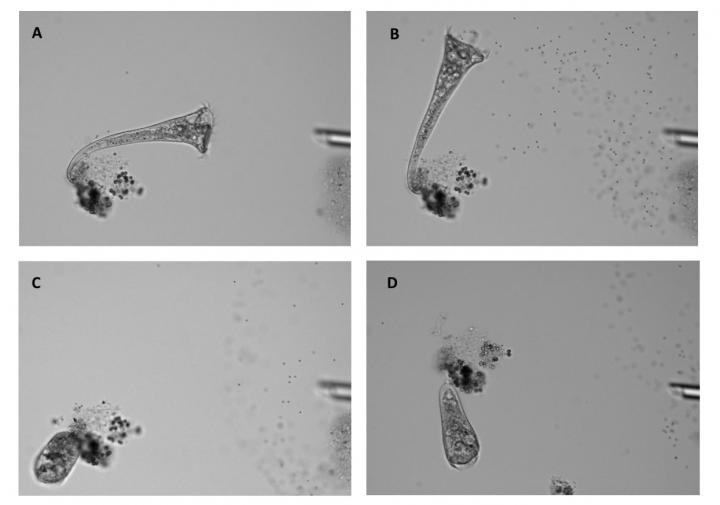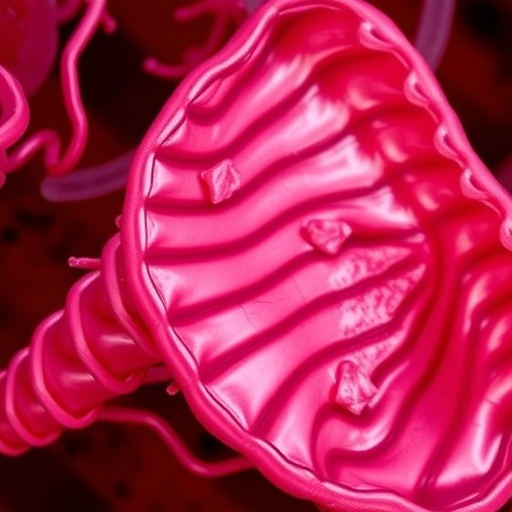Video shows single-cell organism making complex decisions

Credit: Image credit: Joseph Dexter and Sudhakaran Prabakaran/Current Biology.
HANOVER, N.H. – December 5, 2019 – A life of avoidance, detachment and relocation might not be suitable for all, but for the single-cell eukaryote Stentor roeseli, confirmation of this idiosyncratic behavior pattern has been a long time coming.
In a study appearing in Current Biology, researchers at Dartmouth College and Harvard Medical School hope to put to rest a century-old scientific debate by demonstrating that the low-level organism S. roeseli is capable of decision making. They also offer the video evidence to prove it.
In 1906, American biologist Herbert Spencer Jennings reported that Stentor roeseli exhibited complex behavior. In response to an irritating stimulus, Jennings said that S. roeseli engaged in four distinct behaviors–bending, ciliary alteration, contraction and detachment.
The news that the organism, which lacks a central nervous system, possessed sophisticated sensing and response mechanisms sent waves through the scientific community. The findings also played a key role in early scientific debates about animal behavior.
Over a half-century later, the Jennings research was debunked by a 1967 experiment that failed to replicate Jennings’ results. That study was accepted by the science community even though it used a different species of organism.
Now, the Dartmouth-Harvard Medical School team have confirmed Jennings’ original finding.
Through a series of analyses conducted in part at Dartmouth’s Neukom Institute for Computational Science on a project that began at Harvard close to a decade earlier, researchers observed the same avoidance behavior that Jennings noted over one hundred years ago.
“Our results provide strong evidence that Jennings’ original observations about Stentor behavior were correct, which should help to resolve the long-standing confusion,” said Joseph Dexter a fellow at Dartmouth’s Neukom Institute for Computational Science and a lead author on the study. “We now have a transparent dataset, and we invite researchers to view the full set of videos to learn more about the complexities of how S. roeseli responds to stimulation.”
Stentor roeseli is a colorless, trumpet-shaped protozoa that is visible to the naked eye and resembles the sound horn of a Gramophone.
To reconstruct Jennings’ experiment, the team first had to acquire the specific species of organism used in the early 1900s. After an effort that included wading through ponds in southeastern Massachusetts, the team obtained a sample from a golf course in Manchester, England through local supplier Sciento.
The researchers then developed a platform for manipulating the organism that allowed them to target the delivery of an irritant. They settled on using polystyrene beads to stimulate reactions from the organism in the test. This was a departure from the powder used in the original experiment, but it led to an observable response that is thought to be part of a generalized avoidance strategy in S. roeseli.
As the beads were fed through a microinjection needle using a gravity-based system, the researchers worked to keep the microscope image in focus while they observed and recorded the experiment.
In the video, the researchers demonstrate how S. roeseli avoids the irritant by bending away or changing the beat of its hair-like cilia to keep from ingesting it. In response to the irritation, the organism might also contract into a protective ball, or detach from the piece of algae it is anchored to and swim to a new site.
After years of field work, video microscopy, micromanipulation and quantitative analysis, the researchers finally had the evidence that they needed to confirm Jennings’ finding that the single-cell organism is capable of complex avoidance behavior.
“The results are the culmination of a long, highly-collaborative process. It was quite satisfying to work on a problem with such an interesting history and to confront some unusual challenges along the way,” said Dexter.
“Our findings show that single cells can be much more sophisticated than we generally give them credit for,” said senior researcher Jeremy Gunawardena, associate professor of systems biology in the Blavatnik Institute at Harvard Medical School. “They have to be ‘clever’ at figuring out what to avoid, where to eat and all the other things that organisms have to do to live. I think it’s clear that they can have complex ways of doing so.”
In addition to demonstrating how the organism responds to stimulus, the research team also confirmed Jennings’ finding that S. roeseli uses a hierarchy of behaviors. While the team found few instances of the organism following the full hierarchy, they observed many partial instances with varying orders of occurrence, ultimately concluding that the behavior hierarchy exists.
According to the paper, the team considers the behavior hierarchy a form of “sequential decision making in the sense that when given similar stimulation repeatedly, the organism ‘changes its mind’ about which response to give, thereby following the observed hierarchy.”
By generating a much larger and richer dataset than the early 1900s experiment, the team also demonstrates that the organism’s decision making is distinct from habituation or classical conditioning. The team notes that the choice between contraction and detachment in the organism resembled the same probability of a fair coin toss.
###
Sudhakaran Prabakaran, currently with the University of Cambridge and IISER Pune, also participated in this research project.
Media Contact
David Hirsch
[email protected]
Original Source
https:/
Related Journal Article
http://dx.




